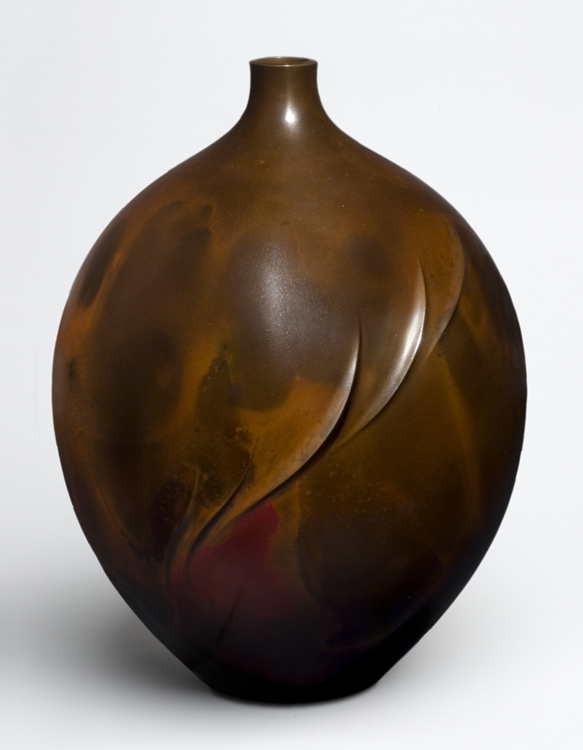
Much has been written about the influence of Japanese design on American and European works of the nineteenth century, but turn the lens in the other direction, looking at the influence of Western art on Japan, and there have been far fewer inquiries. The Art of Japanese Craft: 1875 to the Present, presented at the Philadelphia Museum of Art through fall 2009, fills this gap, highlighting the major movements and materials—many of them Western—that have fueled craft production in Japan since the end of the nineteenth century. Tucked deep inside the museum’s Japanese galleries, just beyond traditional Japanese teahouses, the exhibition displays a large portion of the seventy-piece collection of Frederick R. McBrien III, a promised gift to the museum.

Historically speaking, the large and well-received display of Japanese crafts at the 1876 Centennial exhibition in Philadelphia marked a new era for the arts of Japan, and this is where the current exhibition begins. Westerners were captivated by Japan’s rich lacquerwares, exotic metalwork, intricate woodwork, and of course, ceramics. However, just as the world was being exposed to Japan’s aesthetics, Japanese artists were introduced to Western stylistic movements—from art nouveau to art deco to postwar modernism. While a distinct Japanese aesthetic is recognizable in every work in The Art of Japanese Craft, traces of global influence are also strikingly evident. Morimura Torizō’s Rabbit (c. 1940) in bronze illustrates the point aptly, as modernist style meets a classic Japanese motif.
The most interesting pieces are those from the mid-twentieth century—works rarely seen in Western collections; the lacquerwares alone are worth making the trip. Kaji Kosechi’s Kazari-dana or ornamental display shelves (c. 1930 – 60) combine deep and glossy black lacquer with intricate mother-of-pearl inlay, a technique known as raden. Floral forms are often a motif in Japanese design, and here the irises refer to a famous seventeenth-century set of screens by Ogata Kōrin, a national treasure in Japan.
Equally sumptuous is a Tsuitate screen dating from the 1950s by Itaya Kōji, which incorporates two exacting and time-consuming lacquer techniques. Maki-e, in which gold or silver dust is sprinkled onto the lacquer, is used in the design of the fox’s paws and muzzle, creating a magically soft sheen. The precise hairs of the fox’s fur and the gold blades of grass demonstrate chinkin, a technique in which designs are carved into the lacquer surface and carefully filled with gold leaf. The overall effect is wonderfully expressive and alluring for its subtle sparkle.
The ceramic work of Hamada Shoji’s represents a strong current in Japan at mid-century, and a familiar aesthetic to American eyes. Hamada is perhaps the best-known practitioner of mingei (folk art), a celebration of the Japanese folk style. A skilled potter, he was also important as a teacher and scholar who traveled around the world demonstrating his skill to influence a generation of Western potters.
An earlier piece, Kobayashi Shōun’s Vase with Ivy Designs (c. 1915), also speaks to stylistic intersections with the West. Its richly patinated applied foliate design embraces the same decorative motifs employed by European designers such as Emile Gallé and Daum Frères—interpreted in a more restrained Japanese style. As in the West, minimalist forms came to attention in the postwar period. Sinuous blades of grass blend into abstraction in Takamura Toyochika’s brooding bronze vase (c. 1952), and Takahashi Kaishū’s bronze Pair of Carp (c. 1958), inlaid with silver and shakudo (an alloy of copper and gold), convey their playful nature using only the most basic shapes and lines.
It would be remiss to not mention the pure charm of the depictions of animals throughout the exhibition—perfectly illustrated by Ōta Ryōhei’s wood sculpture Rabbit Gazing at the Moon (c. 1940). While the design demonstrates the artist’s exceptional woodworking skills, it is the distinctly Japanese idea of capturing the spirit of an animal (as opposed to pure representation) that delights.
The Art of Japanese Craft is an illuminating first look at this important collection and I hope it will not be the last. These remarkable art objects deserve to be shown in many new contexts, especially in close proximity to their Western counterparts. The exhibition is accompanied by a slim but comprehensive catalogue, anchored by an insightful historical essay on Japan’s relationship to craft by curator Felice Fischer. A useful reference for scholars and collectors alike, the catalogue illustrates the complete Frederick R. McBrien III collection including maker’s marks, artist biographies, and notes on techniques and materials.
The Art of Japanese Craft: 1875 to the Present will be on view at the Philadelphia Museum of Art through Fall 2009, and the exhibition will be updated with some twenty new pieces from the collection in the spring. For more information visit www.philamuseum.org
